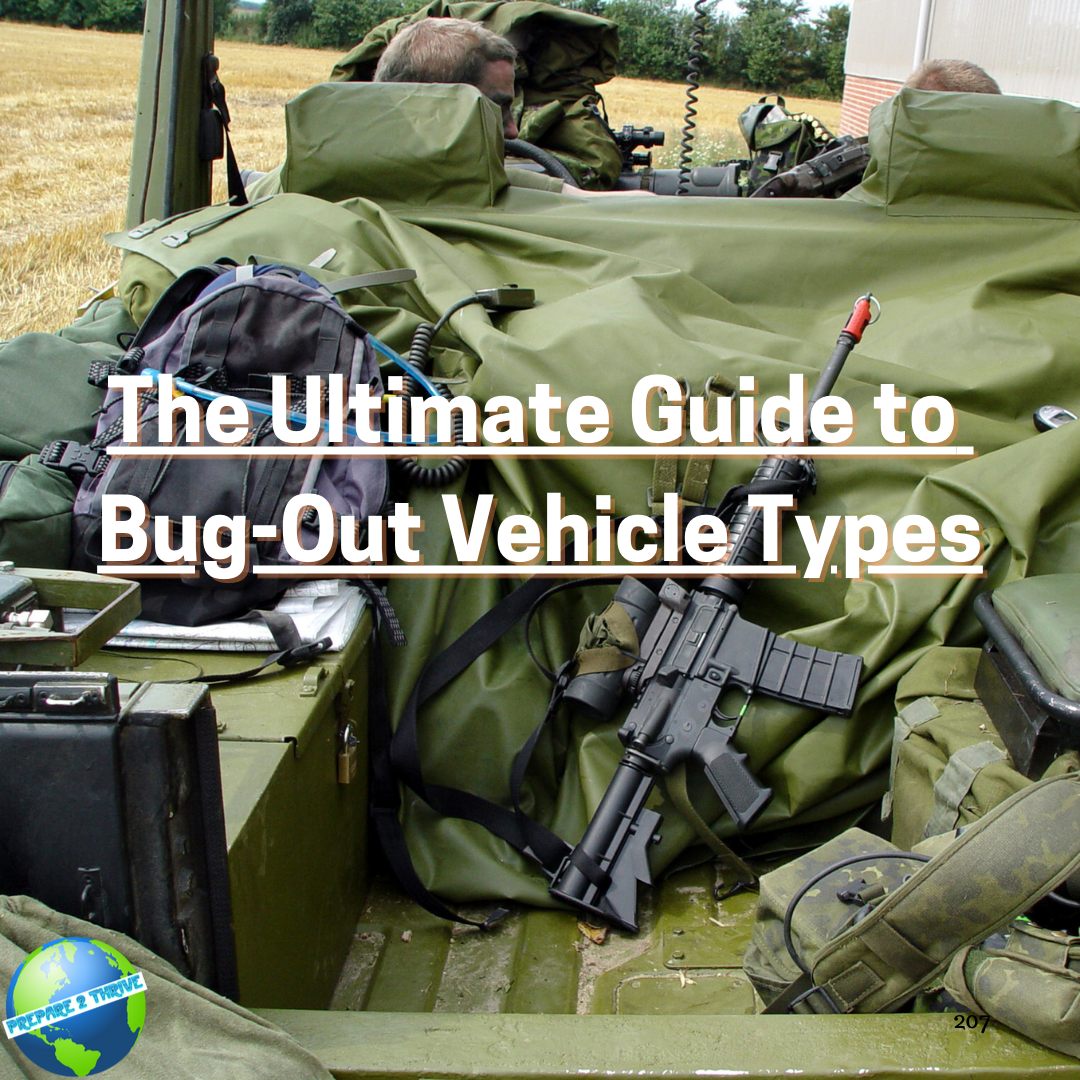Why People Bug Out: Understanding the Need for Emergency Evacuation
In recent years, the concept of "bugging out" has gained popularity in the emergency preparedness community. But what does it mean to "bug out" and why do people feel the need to do it? In this article, we will delve into the reasons behind bug out strategies and their importance in emergency situations.
What is "bugging out"?
Firstly, let's define what it means to "bug out". In simple terms, it is the act of leaving your home or current location in response to a perceived threat or danger. This could be a natural disaster, civil unrest, or any other situation that requires quick evacuation. It can also refer to leaving a densely populated area and moving to a safer location, such as a rural area or a designated emergency shelter.
Some people opt to "bug out" as a preventative measure, with a belief that it is better to be safe than sorry. However, for most people, bug out scenarios are a last resort, when staying put is no longer an option.
Reasons for Bugging Out
There are several reasons why people may feel the need to bug out in an emergency situation. Let's take a closer look at some of the main factors that drive this decision.
-
Natural Disasters
One of the most common reasons for bug out scenarios is natural disasters. Whether it's a hurricane, wildfire, earthquake, or flood, certain types of disasters can make staying in your home extremely dangerous. In these situations, bugging out to a safer location may be the only option. -
Civil Unrest
In times of political or social unrest, there may be a need to leave a city or densely populated area. Civil disturbances, riots, or protests can quickly escalate, putting the safety of individuals and their families at risk. Bugging out may be a necessary step to avoid potential harm. -
Personal Threats
Individuals facing personal threats, such as stalkers or abusive relationships, may also choose to bug out. In these situations, the ability to disappear and start fresh in a new location may be the safest option. -
Infrastructure Collapse
Another reason people may choose to bug out is in the case of an infrastructure collapse. This could include a power grid failure, severe water shortage, or any situation that makes daily life in a city or suburb nearly impossible. Bugging out to a self-sufficient location with food, water, and other necessary supplies is essential in these scenarios.
The Importance of Planning
It is important to note that bug out scenarios are unpredictable and can happen to anyone, anywhere. The key to successfully navigating such a situation is proper planning. Having a plan in place can make the difference between a smooth evacuation and a chaotic, stressful experience.
Bug out planning involves choosing a designated meeting point for your family, preparing for a bug out with essential supplies, and having a well-thought-out evacuation route. It's crucial to constantly review and update your plan, preparing for different scenarios and potential challenges.
Why Some People Don't Bug Out
While for some, the idea of bugging out may seem like a no-brainer, others are hesitant to evacuate. Here are some common reasons why people may choose not to bug out:
-
Financial Constraints
For some individuals and families, the cost of evacuating may be a significant financial burden. From travel expenses to accommodation, bugging out can be expensive. -
Fear of Leaving their Home
The thought of leaving their familiar surroundings and potentially losing their home is a major concern for many people. Human beings are creatures of habit, and leaving our comfort zone can be a daunting prospect. -
Lack of Preparedness
Without proper planning and preparation, most people are not equipped to bug out. For some, the idea of leaving everything behind and starting fresh in an unfamiliar location is overwhelming and not viable.
The decision to leave your home and belongings behind is not an easy one, and it should not be taken lightly. Proper planning and preparation are essential to survive and thrive in a bug out scenario.
Remember, being physically and mentally prepared is just as important as having the necessary gear and supplies. Stay informed and stay vigilant. You never know when a bug out situation may occur, so it's always better to be prepared.
What is the Purpose of a Bug-out Vehicle
A bug-out vehicle, also known as a BOV, is a specially equipped vehicle designed to transport individuals and their essential supplies in case of an emergency. It is a means of transportation that can quickly and efficiently get you and your loved ones out of harm's way. A bug-out vehicle can be any type of vehicle, depending on your needs and budget. It can range from a simple SUV to a fully-equipped RV or even a customized military-style vehicle.
When evacuating, you need to have enough food, water, and medical supplies to last for at least 72 hours, and possibly much longer. This is where a BOV comes in handy. Depending on the size and type of vehicle, you can carry a significant amount of supplies with you, making sure you have everything you need to survive until you can reach a more stable location.
Moreover, a bug-out vehicle is also designed to be self-sufficient. This means it should have the necessary equipment to sustain you and your family for an extended period if needed. This may include a first aid kit, tools for repairs and maintenance, and a generator for power. Some enthusiasts even install solar panels on their bug-out vehicles to reduce dependency on external sources of energy.
In addition to providing transportation and shelter, a bug-out vehicle can also serve as a mobile command centre. It can be equipped with communication tools that allow you to stay informed and connected with the outside world. In times of crisis, information is vital, and having a reliable way to communicate can make a significant difference.
Now that we understand the purpose of a bug-out vehicle let's discuss some essential factors to consider when choosing one. Firstly, the size of your bug-out vehicle will depend on your needs and the number of people you need to transport. A larger family may require a bigger vehicle, while a single person may be able to manage with a smaller one. However, keep in mind that a larger vehicle may be more challenging to manoeuvre in certain situations.
Secondly, think about the type of terrain you may have to navigate during an emergency. If you live in an urban area, a smaller and more agile vehicle may be a better choice. On the other hand, if you live in a rural area, a four-wheel-drive vehicle with higher ground clearance may be more suitable.
Moreover, the reliability of the vehicle is crucial. In times of crisis, you don't want to worry about your vehicle breaking down. Choose a vehicle with a good track record and proper maintenance to ensure it is dependable when you need it the most.
Last but not least, budget is a significant factor when it comes to bug-out vehicles. Depending on the type and modifications, a BOV can be quite expensive. It's essential to consider your budget and choose a vehicle that fits your needs without breaking the bank. Remember, a bug-out vehicle doesn't have to be luxurious; it needs to be functional and reliable.
In conclusion, a bug-out vehicle is an essential part of any emergency preparedness plan. Its primary purpose is to provide transportation and shelter during times of crisis. It should be equipped with the necessary supplies to sustain you and your family, be self-sufficient, and serve as a means of communication. When choosing a bug-out vehicle, consider your needs, terrain, reliability, and budget. With the right vehicle, you can have peace of mind, knowing you and your loved ones are prepared for any emergency.
When to bug-out
When disaster strikes, the decision to bug-out can be a difficult one. With the increasing frequency and severity of natural disasters, pandemics, and civil unrest, it's important to have a solid bug-out plan in place. But when should you actually put that plan into action? Here we will discuss key factors to consider when determining the right time to bug-out and provide tips for a successful evacuation.
Assess the Situation
The first step in any crisis situation is to assess the level of danger. Take a moment to evaluate the threat level and gather as much information as possible. Is the threat immediate and imminent or is it still developing? Is your area under a mandatory evacuation order? Are emergency services and infrastructure still functioning? Your response should be based on the severity of the situation and the resources available.
Stay Informed
In the event of a disaster, it's essential to stay informed. Tune in to local radio stations, check government websites, and follow emergency management agencies on social media for updates and instructions. Additionally, have a designated friend or family member outside of the affected area who can provide you with critical information and updates. This person can also serve as a point of contact for other family members who may need to reach out in case of separation during an evacuation.
Have a Bug-Out Plan
Having a bug-out plan is crucial for a successful evacuation. This plan should include pre-designated evacuation routes, a shelter location, communication plan, and a list of necessary supplies and documents to take with you. Practice executing your bug-out plan with your family or bug-out group to ensure everyone is familiar with their roles and responsibilities in case of an emergency.
Consider the Threat Level
When determining whether to bug-out, the threat level is a crucial factor to consider. If the threat is immediate and life-threatening, it's best to evacuate immediately. This could include scenarios such as a raging wildfire, chemical spill, or an ongoing terrorist attack. In these situations, delaying evacuation could put you and your loved ones in grave danger.
In the case of a developing threat, it's important to closely monitor its progression. This could include a hurricane, flood, or pandemic. If you have a bug-out plan in place, you can start preparing to evacuate once the situation starts to escalate. Remember, it's always better to err on the side of caution and evacuate early rather than waiting until it's too late.
Consider Your Surroundings
Your location and surroundings can also impact your decision to bug-out. For example, if you live in a high-risk area prone to hurricanes or flooding, it may be best to evacuate before the storm hits. On the other hand, if you live in a more rural or isolated area, you may have more time to evacuate before the threat reaches you.
Know Your Limits
Before bugging-out, it's essential to assess your own physical and mental limitations. Can you safely and efficiently evacuate yourself and your loved ones? Do you have any medical conditions that may be difficult to manage during an evacuation? Knowing your limits will help you make an informed decision about when to bug-out and ensure your safety during the process.
Don't Panic, But Don't Wait Too Long
The key to a successful evacuation is to stay calm and make rational decisions based on the information available. It's important to avoid panicking or waiting until the last minute to evacuate. This can lead to chaotic situations and make it difficult to safely leave the affected area.
In conclusion, there is no exact formula for determining when to bug-out. Every situation is different and requires careful evaluation. However, by assessing the threat level, staying informed, having a solid bug-out plan, and considering your surroundings and personal limitations, you can make an informed decision about when to evacuate and ensure the safety of yourself and your loved ones.
Where to Bug-Out: Prepared Location versus No Set Location
When disaster strikes, whether it be a natural disaster or a man-made crisis, having a plan in place for where to go is crucial for survival. Many people choose to have a prepared bug-out location, a designated place where they will go in the event of an emergency. However, for some, having a specific location may not be feasible or desired. In this article, we will explore the pros and cons of having a prepared bug-out location versus not having a set location.
Prepared Bug-Out Location
Having a prepared bug-out location means that you have a designated place to go in case of an emergency. This location is usually prepped and stocked with necessary supplies, making it a safe and secure option for survival. Some may choose to have a bug-out location in a remote area, such as a cabin in the woods, while others may choose a more urban location, such as a family member's house in a nearby city.
Pros:
-
Ready-made shelter and supplies
The most obvious benefit of having a prepared bug-out location is that it is prepped and stocked with necessary supplies. This can include food, water, medical supplies, and even weapons for self-defense. In a time of crisis, having these resources readily available can make all the difference in survival. -
Familiarity with the location
When you have a designated bug-out location, you are likely to be familiar with the area. This can be a big advantage, as you will know your surroundings, potential threats, and ways to navigate the area. -
Controlled environment
With a prepared bug-out location, you have control over the environment. You can customize it to suit your needs and make it as secure as possible. This can include fortifying the location, setting up early warning systems, and stocking up on supplies that are specific to the location. -
Place of refuge
A prepared bug-out location can serve as a place of refuge during a crisis. It can offer a sense of safety and stability during a chaotic and uncertain time.
Cons:
-
Cost and maintenance
Keeping a prepared bug-out location can be costly and require ongoing maintenance. This can include regular visits to the location to check on supplies and make any necessary improvements or repairs. -
Location can become compromised
In the event of a widespread disaster, your prepared bug-out location may not be as secure as you thought. It could become a target for looters or other desperate individuals. -
Travel distance
Depending on the location of your bug-out spot, you may have to travel long distances to reach it. This can be a disadvantage, especially if you need to evacuate quickly.
No Set Location
On the other hand, not having a designated bug-out location means that you have no specific place to go in case of an emergency. In this scenario, you would have to rely on improvising and finding a suitable location on the spot.
Pros:
-
Flexibility
Not having a set bug-out location means that you have the flexibility to choose a location on the spot. This can be advantageous, as you can take into consideration the specific circumstances and choose a location that best meets your needs. -
Less cost and maintenance
Without a designated location, you won't have to worry about the ongoing cost and maintenance of a bug-out spot. -
Less risk of compromise
Since there is no set location to target, your risk of becoming a target for looters or others is lower. Without a prepared location, it will be harder for others to predict your movements.
Cons:
-
Difficulty finding a suitable location
In the chaos of an emergency, finding a suitable location to shelter may prove to be challenging, especially if you are alone and without prior knowledge of the area. -
Lack of preparation
Without a prepared location, you will have to improvise and gather supplies from wherever you can. This can be time-consuming and put you at a disadvantage compared to those with a stocked bug-out location. -
Potential danger
In a disaster situation, if you do not have a designated location to go to, you may end up in an unsafe or dangerous area.
Which Option is Best?
Deciding whether to have a prepared bug-out location or not is a personal choice and depends on various factors such as budget, location, and individual preferences. It is recommended to have a prepared bug-out location if it is feasible and within your means to do so. However, in situations where having a designated spot is not possible, having a backup plan and being able to adapt to the situation is crucial.
How - Types of bug-out vehicles
Feet/walking

In emergency situations, having a reliable bug-out vehicle can be the difference between life and death. Most people immediately think of cars, trucks, or motorcycles as their go-to mode of transportation in a crisis. However, feet and walking can also serve as a viable bug-out vehicle. Here, we will discuss the pros and cons of using feet and walking as a bug-out vehicle in different scenarios.
Pros:
-
Low Maintenance and Cost-effective
Compared to motorized vehicles, feet and walking require very little maintenance. No need to worry about fuel, mechanical issues, or costly repairs. Just make sure you have a sturdy pair of shoes and some basic first aid supplies, and you’re good to go. This makes it an ideal option for individuals on a tight budget or those who cannot afford a vehicle. -
Ability to Navigate Urban Terrain
In an emergency, roads may become congested with traffic or blocked due to natural disasters. With feet and walking, you have the advantage of manoeuvering through tight spaces, taking shortcuts, and utilizing alternative routes. This is especially useful in urban areas that may have buildings and debris blocking traditional roads. -
Discreet and Versatile
Walking allows you to blend in with your surroundings and go unnoticed. You can easily avoid danger and potential threats by staying off main roads and using back alleys or side streets. Additionally, walking provides you with the flexibility to change your route or destination, ensuring that you stay safe. -
Physical Fitness and Endurance
Walking is a great way to keep yourself physically fit and build endurance. In a crisis, you may have to cover long distances on foot, and being in good physical shape will increase your chances of survival. Regular walking also helps to improve cardiorespiratory health, which is essential in stressful situations. -
Can Access Areas Inaccessible To Vehicles
In some scenarios, vehicles may not be able to get you to your desired location. It could be due to narrow paths, rough terrain, or obstacles blocking the way. Walking allows you to reach these places and is especially beneficial in mountainous, rural, or heavily forested areas.
Cons:
-
Slower Than Motorized Vehicles
The most significant disadvantage of using feet and walking as a bug-out vehicle is the speed. Walking is significantly slower than driving, and this can have a severe impact in an emergency situation. You might not be able to cover as much ground as you would with a motorized vehicle, which could delay your arrival at your destination. -
Limited Carrying Capacity
Walking limits the amount of gear and supplies you can carry with you. This could be a disadvantage, especially if you have a large family or need to transport bulky items. Additionally, in extreme situations where you may have to carry essential items such as fuel or water, walking may not be a feasible option. -
Physical Limitations
Walking requires a certain level of physical fitness, and not everyone may be able to walk long distances. Those with limited mobility, injuries, or disabilities may struggle to use feet and walking as a bug-out vehicle. It is important to consider your physical abilities and limitations before relying on walking as your primary mode of transportation in an emergency. -
Vulnerable to Weather Conditions
Walking exposes you to the elements, making you susceptible to weather conditions. If it’s raining, snowing, or extremely hot outside, it can significantly impact your ability to walk long distances. Extreme weather conditions also increase your risk of getting hypothermia or heatstroke, which can be life-threatening. -
Limited Range
Unless you have exceptional physical endurance, walking has a limited range. You may not be able to cover as much distance as you would with a motorized vehicle, limiting your options in an emergency. This is especially true if you need to evacuate to a remote location or a safe zone that is far away.
While it may not be the most obvious choice, feet and walking can be a practical and effective option in certain situations. It is important to consider the terrain, distance, weather conditions, and your physical abilities before making it your primary mode of transportation in an emergency.
Civilian Cars, Trucks and SUVs
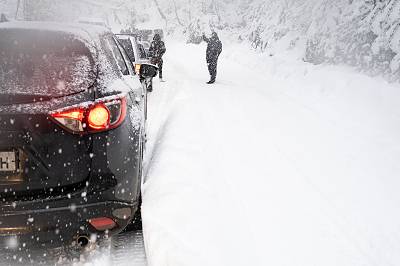
While there are certainly specialized bug-out vehicles available, such as RVs, ATVs, and off-road vehicles, many people overlook the potential of using civilian cars and trucks.
Pros:
-
Versatility
One of the main advantages of using civilian cars and trucks as bug-out vehicles is their versatility. Unlike specialized bug-out vehicles, civilian vehicles are designed to be used for everyday purposes. This means that they can be used for commuting, running errands, and other day-to-day activities, in addition to being used as a bug-out vehicle. This versatility can be a significant advantage in situations where a bug-out vehicle is not needed continuously. -
Availability
In the event of an emergency, specialized bug-out vehicles may be scarce or hard to obtain. On the other hand, civilian cars and trucks are widely available, making them a more practical option for many people. You are more likely to find spare parts, fuel, and other supplies for a civilian vehicle, making it easier to maintain and repair in the long run. -
Familiarity
Most people are already familiar with driving a car or truck, making it easier to operate compared to specialized vehicles. This familiarity can be especially beneficial in high-stress situations, where quick thinking and action are required. In a bug-out scenario, time is of the essence, and not having to learn new controls or functions can save crucial minutes. -
Camouflage
Another advantage of using a civilian car or truck as a bug-out vehicle is its ability to blend in with the crowd. In some emergency situations, having a vehicle that looks too conspicuous can make you a target for theft or looting. With a civilian vehicle, you can blend in with other drivers and remain inconspicuous.
Cons:
-
Limited by Road Closures
Civilian vehicles are limited to use on roads. Should traffic jams, police/military, or hostiles close a road, civilian vehicles may not be able to go anywhere. -
Limited Off-Road Abilities
While civilian cars and trucks are versatile, their off-road capabilities are often limited compared to specialized bug-out vehicles. In bumpy or rough terrains, you may encounter difficulties and even get stuck in a civilian vehicle. This problem can be remedied by using 4x4 trucks, but they are not as versatile as standard cars. -
Limited Storage Space
Unlike specialized bug-out vehicles, civilian cars and trucks do not have as much storage space. In a bug-out scenario, you need to carry essential items such as food, water, and camping gear. In a civilian vehicle, you may have to sacrifice some of your everyday items to make room for these necessities. -
Limited Fuel Capacity
Depending on the type of civilian vehicle, the fuel tank may not be large enough to cover significant distances. This can be a significant disadvantage in a bug-out situation, where you may have to travel long distances to reach a safe location. Specialized vehicles, such as RVs, have larger fuel tanks and can travel farther without needing to refill. -
Maintenance Costs
Owning and maintaining a bug-out vehicle can be expensive, and civilian cars and trucks are no exception. While they may seem like a more affordable option at first, the ongoing costs of maintenance, repairs, and fuel can add up over time. If you intend to use a civilian vehicle as a bug-out vehicle, it's essential to consider these costs.
Conclusion:
Using civilian cars and trucks as bug-out vehicles has both advantages and disadvantages. They are versatile, readily available, and familiar, but their limitations in off-road capabilities, storage space, and fuel capacity should not be overlooked.
Campers/RVs
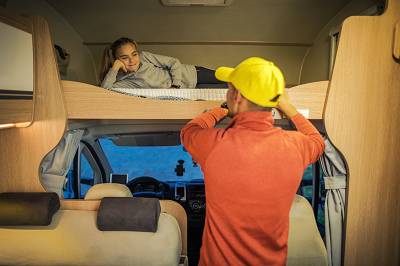
Campers and RVs have become increasingly popular as bug-out vehicles due to their ability to combine both transportation and living quarters. These vehicles, ranging from compact camper vans to spacious motorhomes, offer a mobile and self-contained solution for those seeking to bug out in comfort. Let's examine the advantages and drawbacks of using campers or RVs as bug-out vehicles.
Pros:
-
Mobile Living Space
One of the most significant advantages of using a camper or RV as a bug-out vehicle is the integration of a living space. These vehicles often come equipped with sleeping areas, a kitchen, and bathroom facilities, providing a self-contained shelter on wheels. -
Ample Storage
Campers and RVs typically offer substantial storage space for supplies, making them suitable for families or groups. The storage compartments can accommodate food, water, clothing, and other essential items required for extended periods. -
Comfort and Convenience
With amenities like beds, kitchen appliances, and restroom facilities, campers and RVs provide a level of comfort and convenience not easily achievable in other bug-out vehicles. This can be crucial for maintaining well-being during extended bug-out situations. -
Versatility
RVs are versatile in their ability to navigate various terrains, including both highways and off-road paths. This flexibility allows bug-out plans to adapt to different scenarios and environmental conditions. -
Weather Protection
Unlike some bug-out vehicles, campers and RVs provide protection against the elements. In inclement weather, having a sheltered and climate-controlled space can be crucial for maintaining health and safety.
Cons:
-
Size and Maneuverability
The size of campers and RVs can be a drawback when it comes to manoeuvering through tight spaces or congested urban areas. This may limit their accessibility in many situations. -
Fuel Consumption
RVs tend to have higher fuel consumption compared to smaller vehicles. This can impact the range and overall efficiency of the bug-out plan, particularly in scenarios with limited fuel availability. -
Maintenance Costs
Maintaining an RV can be costly, both in terms of regular upkeep and potential repairs. The complexity of these vehicles often requires specialized knowledge or professional assistance for maintenance tasks. -
Limited Off-Road Capability
While many RVs are designed for versatile travel, they may not be suitable for extremely rugged off-road conditions. Navigating through challenging terrains might be limited compared to more specialized off-road vehicles. -
Initial Cost
Acquiring an RV is a significant financial investment. The initial cost of purchase, coupled with ongoing expenses like insurance and potential campground fees, adds to the overall financial commitment.
Conclusion:
In conclusion, campers and RVs present a compelling option for bug-out vehicles, especially for those seeking a combination of transportation and living quarters. The mobile living space, ample storage, and comfort they offer make them attractive choices. However, drawbacks such as size, fuel consumption, maintenance costs, limited off-road capability, and the initial investment should be carefully considered. Ultimately, the decision to use a camper or RV as a bug-out vehicle depends on individual circumstances, preferences, and the level of preparedness, taking into account both transportation and living requirements during a crisis.
Military vehicles
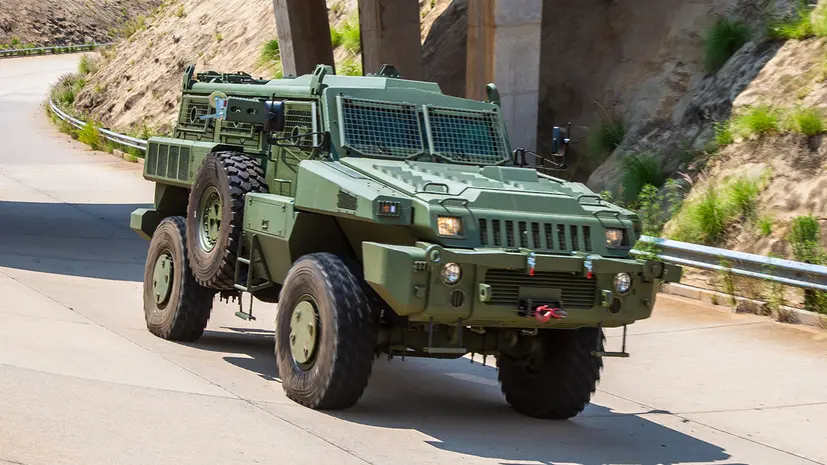
With their enhanced capabilities and hardened design, military vehicles can offer a level of preparedness and protection that other types of vehicles simply cannot match. However, they also come with their own set of challenges and considerations that may not make them the ideal option for every survival scenario. Let's dive into the pros and cons of military vehicles as bug-out vehicles.
Pros:
-
Durability and Reliability
One of the biggest advantages of using military vehicles as bug-out vehicles is their durability and reliability. These vehicles are built to withstand harsh environments, extreme weather conditions, and rough terrains. They have reinforced frames, heavy-duty suspension, and powerful engines that can conquer any obstacles in their way. Additionally, most military vehicles are also designed to be low-maintenance, requiring fewer repairs and replacements, making them a reliable option for long-term survival situations. -
Increased Payload Capacity
Another significant benefit of military vehicles is their impressive payload capacity. These vehicles are designed to carry heavy loads, making them ideal for transporting essential survival gear, supplies, and equipment. Some military vehicles, such as Humvees, have a payload capacity of over 1,000 kgs, while larger vehicles like the Oshkosh M1070 Heavy Equipment Transporter can carry up to 60 tons. This increased capacity allows for more strategic planning and stockpiling of resources for extended periods of time. -
Enhanced Mobility
Military vehicles are specifically designed for mobility, allowing them to navigate through difficult terrain and overcome various obstacles. They are equipped with advanced four-wheel drive systems, high ground clearance, and run-flat tires, making them ideal for off-roading and traversing through rough and uneven surfaces. This enhanced mobility can be crucial in a bug-out situation where traditional roads may not be accessible or safe. -
Armoured Protection
One of the most appealing aspects of using military vehicles as bug-out vehicles is the added protection they offer. Most military vehicles are armoured or have the potential to be outfitted with armour plating, providing a higher level of protection compared to other vehicles. This added protection can be beneficial in case of encountering threats, such as hostile individuals or natural disasters. However, it is essential to keep in mind that the level of armour will vary depending on the type of vehicle, with some offering more protection than others.
Cons:
-
High Cost
The upfront cost of purchasing a military vehicle is undoubtedly higher than that of ordinary vehicles or even off-road vehicles. These vehicles are specially designed and built for military use, and the premium features and equipment come at a higher price. Moreover, the maintenance and operation costs may also be more expensive due to specialized parts and specialized training required for maintenance and repairs. -
Limited Availability
Acquiring a military vehicle may not be as simple as purchasing a regular vehicle. These vehicles are not widely available for purchase, and they are heavily regulated by the government. Depending on the country and location, there may be strict rules and regulations for civilians to own and operate military vehicles. Additionally, finding spare parts for repairs and maintenance may also be challenging and costly. -
Lack of Stealth and Attention
The armoured protection and heavy-duty features that make military vehicles attractive for survival situations can also draw unwanted attention. These vehicles are designed to stand out, both in appearance and sound. In a bug-out situation, the last thing you want is to alert others of your presence or draw unnecessary attention to yourself. The loud engines and distinctive appearance of military vehicles may not be ideal for a low-profile escape. -
Limited Fuel Efficiency
Military vehicles are not known for their fuel efficiency, and this could be a significant drawback in a survival situation. These vehicles have large engines and are heavy, which means they require a substantial amount of fuel to operate. In a bug-out scenario where resources are scarce, this could pose a problem, especially if a predetermined bug-out location requires a significant distance to travel. -
Lack of Border Crossing
In an emergency situation, your optimal choice may be to flee the country. However, most borders will be closed to military vehicles, even retired vehicles.
Conclusion:
In summary, military vehicles offer a unique set of advantages for a bug-out situation, such as durability, increased payload capacity, enhanced mobility, and armoured protection. However, they also have their drawbacks, including high costs, limited availability, lack of stealth, and low fuel efficiency. Ultimately, the decision to use a military vehicle as a bug-out vehicle will depend on your specific survival needs, location, and budget. It is essential to carefully consider all the pros and cons before investing in a military vehicle for your survival plan.
Motorcycles and ATVs
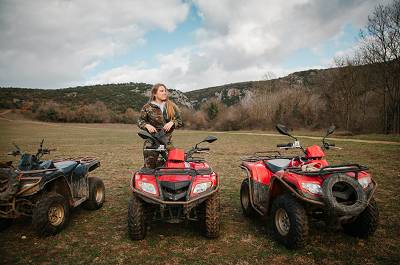
While ATVs are the newest type of vehicle on this list, having been around for only a two decades, motorcycles have been around for over a century and have become a popular choice of transportation worldwide. They are known for their speed, agility, and manoeuvrability, making them a convenient means of transportation in times of crisis. However, when it comes to using motorcycles or ATVs as bug-out vehicles, there are several factors to consider before deciding if they are the right choice for your preparedness plans.
Pros:
-
Off-Road Capability
ATVs, and some motorcycles, are designed for off-road terrain, providing exceptional capability in navigating through rough and challenging environments. -
Mobility and Versatility
Motorcycles and ATVs are known for their ability to navigate through crowded roads and manoeuvre through tight spaces. This makes them a great option for escaping in a fast-moving disaster situation or even navigating through traffic during an evacuation. They can also easily traverse off-road terrain, providing a more versatile mode of transportation than larger vehicles. -
Fuel Efficiency
In a survival situation, conserving fuel is crucial. Motorcycles are renowned for their fuel efficiency, making them an excellent option for bugging out to a remote location or navigating through areas with limited access to fuel. -
Lower Initial Cost and Maintenance
Motorcycles are relatively more affordable than other bug-out vehicles, such as trucks and RVs. They also require less maintenance, making them a cost-effective option in the long run. -
Accessibility in Urban Areas
In a city, where roads can get congested during an emergency, motorcycles can be a more convenient and efficient mode of transportation. They can navigate through small alleyways, bypass traffic, and reach your destination in a short time. -
Camouflage
During a societal collapse or civil unrest, blending in and staying hidden can be crucial for survival. Motorcycles are smaller than other vehicles and can be easily hidden or camouflaged, making them ideal for situations where staying undetected is critical.
Cons:
-
Limited Storage Capacity
Unlike trucks or larger vehicles, motorcycles have very limited storage space. This means you'll have to pack light and strategize your essentials carefully. While ATVs can carry considerably more than a motorcycle, it's still minimal compared to other types of vehicles. -
Lack of Protection
Motorcycles and ATVs offer minimal protection compared to other vehicles. In a disaster situation, where safety is a top concern, motorcycles may not be the safest option, especially if travelling with family or loved ones. -
Difficult Terrain
While motorcycles can navigate off-road terrain, they may not be suitable for rough or extreme conditions. Navigating through rough terrains can be physically demanding, and it may not be feasible to transport larger items on a motorcycle. -
Exposure to Weather Conditions
Riding a motorcycle means being exposed to the elements. In extreme weather conditions, it can be physically taxing, and it may not be possible to carry enough gear to protect you from the elements. -
Limited Seating Capacity
Most motorcycles have limited seating capacity, making it difficult to evacuate with more than one person. ATVs can often carry a second person, but this is still limiting. This can be a significant disadvantage if you have a family or group of individuals who need to evacuate together.
In conclusion, motorcycles and ATVs offer mobility, versatility, and convenience, which make them a popular choice for bug-out vehicles. They are fuel-efficient, affordable, and ideal for urban areas. However, the limited storage capacity, lack of protection, and vulnerability to weather conditions are major drawbacks to consider.
Bicycles
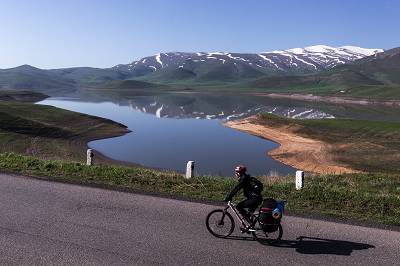
Using bicycles as a bug-out vehicle has many advantages.
Pros:
-
Mobility and Manoeuvrability
Bicycles are small and light, making them easy to manoeuvre through traffic or narrow paths. They are also capable of handling a variety of terrains, from roads to dirt paths, giving you the ability to reach your destination more quickly than a car or truck. -
No Fuel Needed
Unlike cars or trucks that require gasoline or diesel, bicycles do not need any fuel to operate. This can be a huge advantage during a disaster or emergency when gas stations may be closed or out of fuel. As long as you have a functioning bicycle, you can keep moving without worrying about fuel. -
Silent Operation
Bicycles operate quietly, making them ideal for situations where you want to remain unnoticed. This can be important when trying to avoid potential threats, such as looters or dangerous individuals. -
Cost-effective
Bicycles are relatively inexpensive compared to other bug-out vehicles, particularly when you factor in the cost of fuel and maintenance. This makes them a more budget-friendly option for those on a tight budget. -
Self-propelled
As long as you have the physical ability, bicycles are self-propelled, meaning you don't have to rely on external sources of power to keep moving. This can make them a more reliable option during extended periods of time without access to fuel or electricity. -
Good for Personal Fitness
Using a bicycle as a bug-out vehicle not only gives you the means to evacuate safely, but it also provides a form of exercise. In a disaster or emergency situation, where you may be sitting in a car for extended periods of time, riding a bicycle can help keep you physically fit and maintain your mental well-being.
Cons:
-
Limited Carrying Capacity
One of the major downsides of using bicycles as a bug-out vehicle is their limited carrying capacity. Depending on the model, bicycles can typically carry around 50-100 lbs of gear. This may not be enough to carry all the supplies you need for an extended evacuation or if you have a large family. -
Limited Protection
While cars and trucks provide some level of protection from the elements and potential threats, bicycles offer little to no protection. This can make it challenging to navigate through harsh weather conditions or dangerous areas. -
Limited Distance
Bicycles can only take you as far as your physical capabilities allow. If you need to travel long distances or across rough terrain, a bicycle may not be a feasible option. -
Requires Maintenance
Just like any other transportation vehicle, bicycles require regular maintenance to stay in good working condition. This can be a challenge during a disaster or emergency when access to bike shops or replacement parts may be limited. -
Climate-dependent
Bicycles are best suited for areas with mild climates and good road conditions. Harsh weather conditions such as heavy snow, extreme heat, or heavy rain can make it difficult or even dangerous to ride a bicycle.
Bicycles offer many benefits as a bug-out vehicle, such as mobility, cost-effectiveness, and self-propelled operation. However, they do have limitations in terms of carrying capacity, protection, and reliance on physical capabilities. It is important to carefully consider your own needs and situation before choosing a bicycle as your bug-out vehicle. It can also be beneficial to have a back-up plan in case your bicycle becomes damaged or compromised during an evacuation.
Animals (riding and animal carts)
While traditional vehicles such as cars, trucks, and RVs are popular choices for bug-out vehicles, there is another option that may not have crossed your mind - animals. From riding animals to animal-drawn carts, we will discuss the advantages and drawbacks of this unique option.

Riding Animals:
Pros:
-
Manoeuvrability
Riding animals such as horses, camels, and donkeys are highly manoeuvrable and can navigate through rough terrain that may be difficult or impossible for traditional vehicles. -
Low maintenance
Unlike traditional vehicles, riding animals do not require fuel or regular maintenance. As long as they have access to water and forage, they can keep going for an extended period. -
Fast speed
In a bug-out situation, speed is crucial. Depending on the species and breed, riding animals can reach speeds of up to 30 miles per hour, making them one of the fastest bug-out vehicle options. -
Adaptability
Animals are highly adaptable, and riding animals, in particular, have been used for transportation for centuries. They have an innate sense of direction and can navigate through unfamiliar territory with ease.
Cons:
-
Training and experience
Riding an animal requires training and experience, which can be time-consuming and challenging for those without prior knowledge. A rider must also establish a bond of trust and respect with the animal, which takes time to develop. -
Limited range
Unlike traditional vehicles with large fuel tanks, riding animals have limited stamina and can only travel a certain distance before needing rest and food. This can significantly impact your bug-out plan, as longer distances may require multiple animals or frequent rest stops. -
Weather-dependent
Animals are impacted by weather conditions, just like humans. Extreme heat or cold can affect their performance and health, and they may also refuse to travel in heavy rain or thunderstorms.
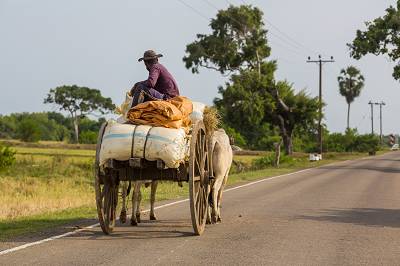
Animal-Drawn Carts:
Pros:
-
Capacity
Animal-drawn carts can carry a significant amount of supplies, equipment, and people, making them an excellent option for families or groups. -
Fuel-efficient
Carts do not require fuel, making them a cost-effective option during a bug-out situation. They also do not produce emissions, making them a more eco-friendly alternative. -
Slow and steady
While traditional vehicles can travel at high speeds, animal-drawn carts have a slow and steady pace. This can be an advantage in some situations, as it allows for improved control and reduces the risk of accidents or injuries.
Cons:
-
Limited navigation
Animal-drawn carts are not as manoeuvrable as riding animals, making them less suitable for navigating through rugged terrain or tight spaces. This can limit your routes and may take longer to reach your destination. -
Weather-dependent
Just like riding animals, animal-drawn carts are also impacted by weather conditions. They may struggle with steep inclines or rough terrain, and heavy rain or snow can significantly slow down their progress. -
Animal welfare
While riding animals may have a better chance of survival due to their adaptive nature, animal-drawn carts are more vulnerable. In a prolonged bug-out situation, animals may succumb to fatigue or injury, making them no longer a viable bug-out option.
In conclusion, using animals as bug-out vehicles has its advantages and drawbacks. They are highly adaptable, low maintenance, and can navigate through difficult terrain. However, they require training and experience, have limited range, and are weather and animal welfare-dependent. Ultimately, whether using riding animals or animal-drawn carts is a suitable option for you will depend on your circumstances and preparedness level.
As with any bug-out vehicle, it is essential to have a backup plan and consider the long-term impact on the animals, especially in a prolonged bug-out situation. Proper training, equipment, and supplies for the animals should also be part of your bug-out plan.
Aircraft (fixed and rotary wing)
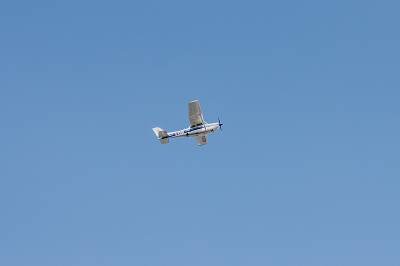
Aircraft, both fixed-wing and rotary-wing, have also gained attention as bug-out vehicles. Here we will explore the advantages and disadvantages of utilizing aircraft as your primary mode of transportation in case of an emergency.
Pros:
-
Quick and Efficient Travel
One of the biggest advantages of using an aircraft as your bug-out vehicle is its ability to cover long distances in a short amount of time. Unlike regular ground vehicles, which are limited by roads and traffic, an aircraft can travel in a straight line to reach your designated bug-out location. This can be especially advantageous in cases of natural disasters or civil unrest when roads may be damaged or blocked. -
Versatile Landing Options
Aircraft offer more flexibility in terms of landing options compared to traditional vehicles. They can land on a variety of surfaces including paved runways, grass fields, and even water bodies. This makes it easier to access remote or hard-to-reach locations, providing more options for bug-out destinations. -
Capacity and Carrying Ability
Aircraft can have the ability to carry more weight. This means you can transport a larger amount of supplies, equipment, and people in one trip, making it a more efficient bug-out option for families or larger groups. -
Heightened Safety
In some emergency situations, roads may not be safe to travel on, making aircraft a safer option. They can fly above dangerous areas, avoiding roadblocks or threats on the ground. Additionally, most aircraft have advanced safety features such as emergency parachutes, anti-icing systems, and GPS navigation, making them a reliable mode of transportation in case of an emergency. -
Border Crossing
Aircraft have the ability to easily cross borders. This can be vital during a crisis situation. While landing should be restricted to authorized airfields, where you would check-in, it is possible to land elsewhere and avoid the border controls (not legal, or advisable, but possible).
Cons:
-
Expensive Initial Cost
It’s no secret that aircraft are expensive. Purchasing, maintaining, and storing an aircraft can be a huge financial burden. This makes aircraft a less accessible option for those on a budget. However, for some, the cost may be worthwhile considering the benefits it offers in terms of safety and efficiency. -
Maintenance and Training Requirements
Aircraft require regular maintenance to ensure they are in top condition for emergency situations. This includes routine check-ups, repairs, and updates, which can be costly and time-consuming. Additionally, pilots need to be trained and licensed to operate an aircraft, making it a less viable option for those without prior experience. -
Limited Cargo Space
While aircraft offer the advantage of carrying heavy loads, the amount of available cargo space may be restricted. Some aircraft models have a designated weight limit, which means you may not be able to carry all your necessary supplies and equipment in one trip. -
Dependence on Fuel
Like any other vehicle, aircraft also require fuel to operate. In case of a prolonged crisis, resources such as fuel may be scarce, making it difficult to use an aircraft as a long-term bug-out solution. Additionally, the cost of fuel can be significant, which may not be feasible for everyone. -
Flight Restrictions
Under certain circumstances, flying may be restricted, or outright banned. During 9/11, all aircraft in North America were grounded, with a complete ban on all non-military aircraft. Likewise, during the COVID pandemic, many regions restricted private aircraft use.
In conclusion, while aircraft have their own set of advantages, they may not be a practical bug-out option for everyone. Their high cost, maintenance requirements, and fuel dependence can make them inaccessible and unsustainable for some. However, for those who can afford it, aircraft offer a fast, efficient, and versatile option for bugging out in emergency situations.
Boats (power and sail)

The success of a bug-out plan often depends on the type of bug-out vehicle chosen. A well-equipped and properly maintained bug-out vehicle can provide a means of transportation during a crisis, allowing individuals or families to escape danger and reach a safer location. In this series, we have discussed different types of bug-out vehicles, such as cars, trucks, motorcycles, bicycles, and even alternative options like horses and RVs. In this final article of the series, we will be discussing the pros and cons of using boats as bug-out vehicles.
Boats, whether powered by engines or sails, have been used as a means of transportation for centuries. They have played a crucial role in exploration, commerce, and travel. They can also serve as effective bug-out vehicles, providing a means of escape during a disaster. However, just like any other bug-out vehicle, they come with their own set of advantages and disadvantages. Let's take a closer look at the pros and cons of using boats as bug-out vehicles.
Sailboats have an added benefit in that they can be lived in full-time, before any need for bugging out. Even living in a major city is possible, and likely much less expensive, to live on a sailboat than to live in a house.
Pros:
-
Mobility and flexibility
One of the biggest advantages of living on a sailboat is the freedom and mobility it provides. Living on a sailboat allows you to easily relocate and explore new places without being tied down to a specific location. It also provides a sense of independence as you have full control over where you go and when you leave. In case of an emergency, a bug-out sailboat can be a useful tool for evacuating from an area quickly. -
Self-sufficiency (generating own electricity, water, and food)
Living on a sailboat encourages self-sufficiency and reduces dependence on external resources. Many sailboats are equipped with solar panels and wind turbines that generate electricity, and watermakers that turn seawater into potable water. Furthermore, fishing and growing your own food are popular activities among sailboat dwellers, allowing them to be more self-sufficient in their day-to-day life. -
Low cost of living
Living on a sailboat can be much cheaper than living on land. Sailors don't have to pay rent or mortgage, property taxes, and other expenses that come with owning or renting a home. The cost of maintaining a sailboat is also lower than maintaining a house or apartment, as long as regular maintenance is performed. -
Versatility
One of the biggest advantages of using boats as bug-out vehicles is their versatility. Boats can travel on water, which means they can take you to remote or hard-to-reach locations that other vehicles cannot access. This can be advantageous during a disaster, as you can escape to a remote island or a safer location on the water. -
Can Carry Large Amounts of Supplies
Depending on the size and type of boat, they can carry a significant amount of supplies, making them an ideal bug-out vehicle for families or groups. Boats equipped with a cabin or storage areas can hold food, water, fuel, and other essential supplies needed for survival. -
Can Be More Fuel Efficient
Boats that use sails as their primary source of power can be incredibly fuel-efficient, as they do not rely on traditional fuel sources. This can be beneficial in a disaster situation where fuel may be scarce. -
Less Traffic and Obstacles
On the water, there are fewer obstacles and traffic compared to roads and highways on land. This can make it easier to navigate and reach your bug-out location without encountering roadblocks or heavy traffic. -
Difficult to Track
Boats are more difficult to track compared to land vehicles. In a disaster scenario, where law enforcement and government authorities may be trying to control the movement of people, using a boat as a bug-out vehicle can provide a level of anonymity and security.
Cons:
-
Expensive
Purchasing a boat is a significant investment, and maintaining it can be expensive. In addition to the initial cost of purchasing a boat, you will also need to consider ongoing costs such as mooring fees, insurance, and maintenance. However, is using the boat as your primary residence, then this can actually be the least less expensive of all the options listed. -
Requires Specialized Skills
Operating a boat is not as simple as driving a car. It requires a certain level of knowledge and skills to navigate through the water safely. If you are not familiar with boating, it can be difficult to learn and operate a boat during a crisis. -
Limited Mobility
Although boats can access hard-to-reach locations, they are still limited in their mobility. They cannot travel on land, which means you may need to leave your boat behind and continue your journey on foot or by other means of transportation. -
Vulnerable to Extreme Weather
Boats are vulnerable to extreme weather conditions such as strong winds and rough seas. This can make it challenging to navigate and can also cause delays in reaching your bug-out location. -
Limited Storage Space
While boats can carry a significant amount of supplies, they are still limited in storage space compared to other bug-out vehicles such as RVs or trucks. This means you will need to carefully plan and prioritize what supplies to bring with you on the boat.
In conclusion, just like any other bug-out vehicle, boats have their own set of advantages and disadvantages. Their versatility and ability to carry large amounts of supplies make them an attractive option for bug-out vehicles. However, the high cost, specialized skills required, and vulnerability to extreme weather may make them less feasible for some individuals. Ultimately, the decision to use a boat as a bug-out vehicle depends on personal circumstances, location, and desired level of preparedness.
The following table tries to compare important aspects of each type of BOV in a fair, equitable manner.
Some notes:
- For boats, "recreational" would encompass any boat that you own that you do not live in. This could be a 20' runabout that cost $1000, or a 100' superyacht in the millions. If you live in a house/apartment, and own a boat for weekends or holidays, then it's recreational (on this chart). Live-aboard boats would encompass people who live full time in their boat. As such, the purchase price and maintenance could be considered zero, because you aren't buying a BOV, you're buying a house... the BOV part is free. But they are shaded in pink because they can cost a considerable amount to purchase and maintain.
- Aircraft have a zero / 5 star rating for road closures. Traffic and road closures will not affect aircraft. However, if there is still a functioning government, they can close the airspace and prohibit aircraft. They did this in North America following 9/11, and in various locations around the world during the COVID pandemic. If the government has collapsed, then air travel is unrestricted.
- Walking has a 0 / Infinite rating for passengers. You can't carry any passengers. But any number of people can walk with you.
| Feet / walking |
Cars, Trucks and SUVs |
RVs & Campers |
Military vehicles |
Motorcycles & ATVs |
Bicycles | Riding Animals |
Animal-Drawn Carts |
Aircraft | Recreational Power Boats |
Recreational Sailboats |
Live-aboard Trawler |
Live-aboard Sailboats |
|
| Lower is better | |||||||||||||
| Purchase Price | 0 | $$$ | $$$ | $$$$ | $$ | $ | $$ | $$ | $$$$$ | $$$ | $$$ | 0 / $$$$$ | 0 / $$$$ |
| Maintenance Costs | 0 | $$ | $$$ | $$$ | $$ | 0 | $ | $ | $$$$$ | $$$ | $$ | 0 / $$$$$ | 0 / $$$$ |
| Maintenance Requirements | 0 | ** | ** | **** | ** | * | * | * | ***** | ** | * | *** | ** |
| Noise Level | 0 | *** | *** | **** | ***** | * | * | ** | ***** | *** | 0 | ** | * |
| Road Closure/Traffic Effects | 0 | ***** | ***** | **** | * | * | * | ** | 0 / ***** | 0 | 0 | 0 | 0 |
| Physical Fitness Requirements | ***** | * | * | ** | *** | **** | *** | ** | * | * | ** | ** | *** |
| Training and experience | 0 | * | *** | *** | ** | * | ** | *** | ***** | ** | *** | *** | **** |
| Track Evidence | * | ***** | ***** | ***** | ***** | *** | *** | *** | 0 | ** | 0 | * | 0 |
| Higher is better | |||||||||||||
| Versatility (non-bug-out use) | ***** | **** | *** | *** | **** | ***** | *** | *** | *** | **** | **** | ***** | ***** |
| Self-sufficiency | 0 | * | **** | * | 0 | 0 | 0 | 0 | * | * | ** | **** | ***** |
| Availability | ***** | ***** | *** | * | ***** | ***** | *** | ** | * | **** | **** | *** | *** |
| Familiarity | ***** | ***** | *** | ** | **** | **** | *** | ** | * | *** | ** | *** | ** |
| Urban Mobility | ***** | **** | *** | **** | ***** | ***** | **** | **** | N/A | N/A | N/A | N/A | N/A |
| Rural & Off-Road Mobility | ***** | *** | ** | ***** | ***** | ***** | ***** | ***** | ***** | ***** | ***** | ***** | ***** |
| Border Crossing Ability | **** | **** | **** | * | **** | **** | ***** | **** | ***** | ***** | ***** | ***** | ***** |
| "Grey-Man" Camouflage | ***** | ***** | *** | 0 | ***** | ***** | ***** | *** | 0 | ***** | ***** | **** | **** |
| Passenger Capacity | 0/∞ | **** | ***** | **** | * | * | * | ** | *** | *** | *** | ***** | ***** |
| Cargo Capacity | * | *** | **** | ***** | ** | * | ** | *** | *** | *** | *** | ***** | ***** |
| Speed | * | **** | **** | *** | **** | ** | ** | ** | ***** | *** | ** | ***** | **** |
| Fuel Efficiency & Range | ***** | *** | *** | * | **** | ***** | ***** | ***** | **** | *** | ***** | **** | ***** |
| Protection From Elements | 0 | ***** | ***** | ***** | 0 | 0 | 0 | 0 | *** | ** | ** | **** | **** |
| Protection From Hostiles | 0 | * | * | ***** | 0 | 0 | 0 | 0 | ***** | *** | *** | ***** | ***** |
Hashtags: #Aircraft #animaldrawncarts #Boats #Bicycles #bugout #bugoutlocation #bugoutplan #BugOutVehicles #civilunrest #disasterpreparedness #emergency #emergencyevacuation #emergencyplanning #EmergencyPreparedness #familyemergencyplan #evacuation #evacuationroute #MilitaryVehicles #naturaldisaster #OffRoading #pandemic #Prepping #preparedness #prepper #ridinganimals #Safety #shelter #Survival #survivalskills #SurvivalPreparedness #SurvivalTransport
